Citation: Robert David STEELE Vivas, “The Human Factor & The Human Environment: Concepts & Doctrine? Implications for Human & Open Source Intelligence,” Phi Beta Iota Public Intelligence Blog (12 December 2012).
For Part II See: 2012 Robert Steele: The Human Factor & The Human Environment: Contextual Trust for Sources & Methods
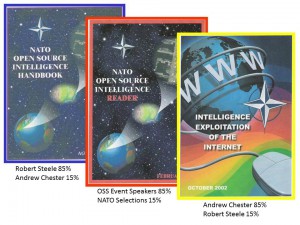
UPDATE 16 Dec 2012: Added NATO OSINT Series, pointer to other OSINT Handbooks. Added Thomas Briggs: Reflections on OSINT in Support of HUMINT
UPDATE 15 Dec 2012: Robert Steele: How Dutch Intelligence Survived & Prospered Using Open Source Human Intelligence as a Foundation for Ethical Evidence-Based Decisions
UPDATE 14 Dec 2012: 2012 Tom Briggs on The Human Factor & 2012 Ishmael Jones (P) on The Human Factor
Hi Robert,
There is one consideration I would like to discuss with you. While exploring for many years how to address the need for the military to understand all areas and aspects of the human environment, I had the opportunity to listen to many members of the intelligence community speaking about their role in achieving that understanding. I used to have the traditional military idea that it was the role of intel to provide the information and much of the knowledge. Along the way, they got me to doubt this view. Finally, they convinced me that the intel community, as we still know it today, is not a supplier of this understanding, but a customer. Understanding the human environment is a product stemming from Open Sources Information, but not from military intelligence. Intel's role might be, based on the understanding made available by others, to develop the specific products suiting its specific goals : targeting and counter intelligence.
As a general statement, no one nation has put this together — the Mediterranean countries have the skills and mind-set, the Sandanavian countries have the motivation and interest, and the Americans have the money — but the three “sets” are not coming together at this time.
Thank you for all the material you are producing.
Cheers,
REDACTED
Long Answer with Graphics to Four Part Question Below the Line
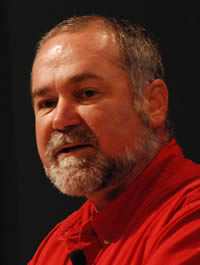
Click on Image for Personal Web Page
THE QUESTION
The question I have been asked to answer can be divided into four parts.
Part I. Why does the secret intelligence community refuse to address non-secret sources and methods in a comprehensive and responsible fashion?
Part II. Why does the military not focus more — and effectively — on understanding the “human terrain” within which it must operate?
Part III. Today, right now, what can we do to dramatically improve the ability of the military — not just a single military but a multinational coalition military also working with civil sector partners — to get a grip on the human factor, and equally important, how should overt human sources be handled, and who should be responsible for collecting, processing, analyzing, and dissmeinating human understanding relevant to military strategy & priorities, military policy-making, military acquisition, and military operations?
Part IV. What role should external human factors play in our own military decision-making, and who is responsible for understanding and interpreting for the commander, the human environment?
It is my pleasure to offer answers to these four questions, and to do so in particular reference to the North Atlantic Treaty Organization (NATO) and the Partnership for Peace (PfP), whose chiefs of military intelligence (60+) I was invited to address in 2000 (see references below). This post is directly pertinent to everything the Allied Command Transformation (ACT) is endeavoring to address.
INTRODUCTION
WHAT IS The Human Factor? The human factor is a melange of prior human indicators of plans & intentions; actual human performance across a range of functions or mission areas; and post-contact human reactions, actions, and new indicators of plans & intentions. In military terms, the human factor must be considered at multiple levels — at the national command level, the theater command level, the unit command level, and within a unit, across varied performance responsibilities and all mission areas, from speed of march to accuracy of fire to endurance. When engaged in operations where a civilian populace is a relevant planning factor, the nature of the non-military humans must be considered, to include their ethnic, liguistic, and other ideo-cultural and techno-demographic attributes and distinctions. Cultural intelligence is a small slice of Human Factor understanding — in its broader meaning, it encompasses all that we can know about people, their abilities, characteristics, and limitations, in relation to all physical equipment and structures and all natural attributes of their total environment. [The Human Terrain Team (HTT) is a great concept badly managed — zero integrity. It needs to be ripped away from its present roots, and brought under DIA full-spectrum HUMINT management with my kind of perspective, not the prevailing perspective at DIA.] Below is one academic definition:
Human Factors is a multidisciplinary field incorporating contributions from: psychology, cognitive science, engineering, industrial design, statistics and anthropometry. Human Factors psychologists examine: virtual environments, simulators, biometrics, anthropometrics, usability, cognitive workload and situation awareness, the impact of stressors and fatigue on performance, human computer interaction (HCI), human machine interaction (HMI), automation and integration of autonomous system attributes, display and interface configuration and optimization, motion induced interruptions, etc. Source
At the national command level, the human factor can be separated with respect to strategy, policy, acquisition, and contingency planning (internal) and also with respect to the public, media, religion, and other human conglomerations in a position to impact on military planning, programming, budgeting, and execution (specific Senators, for example). For longer-term studies, the human factor in being able to adapt rapidly to challenges is fundamental–the ability of entire communities or nations to turn to and design, build, and test a landing craft in 24 hours, or turn out one Liberty Ship a day, is a major factor in determining how that nation-state might do in long-lasting conflicts. Similarly, the human factor in agriculture, manufactrruing, or other areas that might suddenly lose energy or water and need radical human adaptation, is relevant to the resilience of any given community or nation. In times of crisis, the ability to switch out high-ranking individuals promoted in peacetime who cannot cut it in wartime, bringing back in very experienced iconoclasts to reinforce the younger commanders that do “get it,” is essential.

In an academic sense, human factors is narrowly focused on the “fit” between an individual and the physical/mechanical systems they are trained to use. In a military sense, the mental, moral, and emotional breadth and depth of each individual is substantially more important and impacts on health & safety as well as military effectiveness at the individual and unit level. In a practical sense, the human factor determines the ability of an organization to recognize change, adapt to change, and sustain its effectiveness in the face of massive confusion, conflicting signals, or catastrophic conditions.
The graphic above is simplistic and crude, but we need to be able to do this level of nuance, and Human Intelligence (HUMINT) and Open Source Intelligence (OSINT) are the only means to actually get to reliable character evaluations. The interaction between man and machine, between man and chaos, can be studied, can be analyzed, and can provide an “edge” to any commander that enables a holistic analytic endeavor — that is to say, one with integrity that does not compromise the truth about either their human factors or our human factors. To be most effective, it must include an honest analysis of the home team across all elements at all levels. It should also include clear-cut human paths to technical choke points, especially in the rear area where covert HUMINT can wreak havoc but demands the combination of truly clandestine human access and deep subject matter expertise to get the sabotage exactly right.
The human factor is the Achilles heel of any complex system — from an Air Force jet that allows stealth toxins to poison pilots, to oil platform engineers that accept illegal orders to turn off all the safety valves, to Japanese engineers who tolerate decades of unsafe construction and practices at a nuclear reactor — the human factor is the Wild Card.
To paraphrase and augment a response from Ralph Peters: do not ever underestimate the inclination and capacity for any number of humans from one to infinity, to engage in extreme violence AND do not underestimate the value of our own engagement in extreme violence when only violence will compel surrender. ALSO do not underestimate the value of a gifted analyst with deep subject matter (regional, cultural, linguistic) knowledge. Outputs — and an uncanny ability to connect dots no one else can see — is what marks a gifted analyst. They have to be found and protected at whatever age. Technical anything produces INFORMATION; our real failing is on the analytical side, where our “leaders” really believe that anybody with a college degree from a middling university can instantly become a useful intelligence analyst regardless of their source mix (including sparse open sources). Only the analyst can produce INTELLIGENCE; only the most gifted of analysts can produce compelling WARNING INTELLIGENCE.
WHAT IS The Human Environment?
The human environment can be interpreted in two general ways. The first, which is militarily significant, is the totality of the human society in all of its permutations, as relevant to military planning and operations including exit strategy. In an ideal world. before the military goes in, it will have both a complete understanding of the human environment, and also have not just rules of engagement but projected end states for the human society within which it will be operating.
At a much higher level of analysis, the human environment is that part of the environment that is made or modified by humans for humans. Some call this the anthrosphere. This is a much more idealistic — some would call it intrusive as well a predatory — definition that seeks to impose United Nations conventions on Member states and their human environment. From a United Nations perspective, the safeguarding of natural resources including wildlife and oceans is called for. The rule of thumb is that the human environment should not do anything that exceeds the capacity of the Earth to clean itself naturally.
CONTEXT
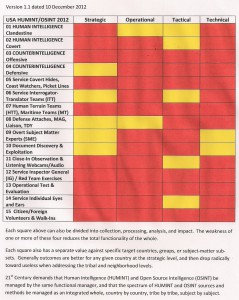
With a salute to those that came before, particularly Jan Herring, former National Intelligence Officer for Science & Technology in the 1970's, George Marling, staff to the Intelligence Producers Council (IPC) in the 1980's, and Tom Pedtke of the Air Force, Tim Hendrickson of Army, Gordon Oehler, Diane Webb and Dennis McCormick of CIA, I will observe that we have had at least three chances to get it right–in 1992 (MITRE mislead CIA, which buys idea of an Open Source Information System–OSIS–with six sources [I do not make this stuff up!], refuses USMC suggestion of an air-gapped center outside the wire with access to all open sources in all languages), 2000 (NATO N-2 commissions OSINT project, I write The New Craft of Intelligence as both an Army monograph and a published book, Sean O'Keefe approves $125M IOC for OSA, then leaves for NASA), and 2006, when then Colonel Vince Stewart did the first defense-wide look at Open Source Intelligence (OSINT) and found — in my words– “more lying, back-stabbing, and deep unethical behavior” than he had ever before encountered in his previous three decades of service. Sadly, Jim Clapper, always the technophile, fell prey to the misconception that OSINT is a technical challenge rather than a deeply integrated inseparable conjoined twin of HUMINT, the theater commanders fell prey to outrageous promises from CIA that were not kept, and OSINT was left to fester as a mix of CIA T-1 lines lacking deep analytics, beltway bandit butts in seats lacking deep analytics, and a horrible mix of Document Exploitation (DOCEX) as a “new discipline” (code for another senior executive position) lacking in needed language skills, and superficial Internet surfing lacking in multinational, multiethnic, multilingual Subject Matter Experts (SME). Above is my current evaluation — from the cheap seats on the sidelines — of where we are in relation to each of the fifteen slices of HUMINT-OSINT that I identified in 2010 as requiring integrated management and capabilities development. A quarter century has been wasted–not only in OSINT, but in letting CIA continue to get away with zero HUMINT for military policy, acquisition, and operations, and in failing to leverage the peace dividend to completely restructure how we train, equip, and organize our military forces. On a positive note, we now know what we need to know to avoid the mistakes of the past.
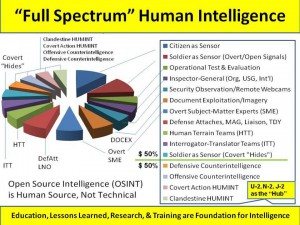
In 2008 I was interviewed to be the Defense Intelligence Senior Leader (DISL) for DIA/DH, and I was very enthusiastic about the possibilities of not only revitalizing DH, but under DH's nurturing, creating a conjoined twin, DO, eventually getting all of our defense human assets under coherent purpose-driven management. Inspired by my interaction with the selection committee (especially Peter W., then Chief of Staff of DH), I went home and in one sitting drafted what is now Human Intelligence: All Humans, All Minds, All the Time (U.S. Army Strategic Studies Institute, 3 June 2010), properly pre-cleared by DoD and also pre-cleared by CIA. It was here that I coined the term “full-spectrum HUMINT” as depicted in this now classic graphic. [P.S. I've never been about rank or money — will gladly accept any job offer in the HUMINT/OSINT arena, I just need an adjudicating authority with integrity.]
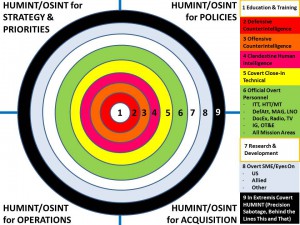
So here we are. NATO has — at least for now — a US Navy Admiral (James Stavrides) that “gets it” and has called for “Open Source Security,” the defense community has finally realized that CIA has never and will never provide clandestine HUMINT for military policy, acquisition, and operations needs, and everyone is struggling with the challenge of creating their own clandestine HUMINT capabilities while neglecting, in my view, the opportunity to finally develop full spectrum HUMINT — an integrated blend of OSINT, HUMINT, and in extremis covert action HUMINT as I depicted in my earlier chart reproduced here. The Allied Command Transformation (ACT) has a human focus but has not gotten into 21st Century intelligence concepts, including particularly the urgency of restoring HUMINT-OSINT as the primary discipline, subordinating information technology and technical collection to a support role, while implementing M4IS2.
Part I. Why does the secret intelligence community refuse to address non-secret sources and methods in a comprehensive and responsible fashion?
The secret world refuses to take open sources seriously for two reasons:
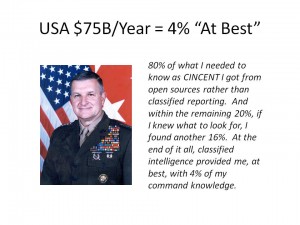
01. They consider open sources and methods the responsibility of the consumer — the policy, acquisition, and operations elements of the government that they pretend to support with secret intelligence. In fact they provide “at best” 4% of what a major commander needs, and nothing for anyone else, precisely because they narrow their focus so sharply. Unfortunately, apart from being irresponsible about not demanding that “all-source” analysts actually have access to and are masters of open sources of information, security phobias have destroyed the ability of the average analyst to actually have a professional conversation with someone who is not a US citizen and has not received a secret clearance. Call a non-US expert long distance and you will be investigated and perhaps even suffer attempted intimidation at the hands of a goon with no clue. [The “consumers” of intelligence are incompetent at creating intelligence from open sources — they are ideologically and financially driven, with decisions made on the basis of what special interests want to receive, rather than on the basis of ethical evidence.]
02. The secret world is also absolutely certain that most open sources are disinformation, and that only information that is “stolen” can be “trusted.” This was partially true during the early years of the Cold War in relation to Russia and China. They have never been seriously focused on anything other than “hard targets” and thus do not realize that this is not true in relation to Global Coverage. They are oblivious to the fact that the countries from whom we have stolen codebooks know that we have stolen them and manage their signals traffic accordingly; that everyone knows where the imagery satellites are and plans accordingly; and finally, that 90% or more of CIA's “clandestine” information consists of hand-me-downs from foreign liaison or legal traveler debriefings done in the USA, and that at least 80% of CIA's “clandestine” case officers under official cover are completely blown to local liaison within a couple of weeks of their arrival.
Part II. Why does the military not focus more — and effectively — on understanding the “human terrain” within which it must operate?
The people in charge of the military today came of age in the 1950's, during the Cold War. The following two phrases capture their mind-set:
01 We are responsible for creating the maximum possible amount of violence in the smallest possible space, so as to achieve political objectives. I remember this from Marine Corps force structure discussions in the 1990's when I was the senior civilian at the Marine Corps Intelligence Center, and tried to suggest a reduction of shooters and an increase in thinkers (as I recall, under 1000 billets).
02 Real men do not do Operations Other Than War (OOTW). This is a quote from a former Chairman of the Joint Chiefs of Staff (JCS), a Curtis LeMay/Merrill McPeak personality, but I forget the name.
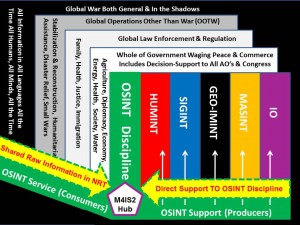
There is a third reason, and this one is directly related to the corruption of the military Planning, Programming, Budgeting, and Execution (PPBS/E) system, in which “things” that cost a great deal of money are more valued than individual human beings, what both Rommell and Krulack have called “the strategic corporal.” This third phrase captures what the US military refuses to understand, using the example of drones as a vehicle for both observing and killing. Here to the side I show all of the global functions that Whole of Government must be able to execute, and confirm my view that the military is the hub of all global engagement for the simple reason that it is the only element of government that can move, shoot, and communicate anywhere on the planet on a no notice basis. This graphic also shows the relationship of OSINT as a supporting sub-element of each of the classified intelligence disciplines and as the primary means for harmonizing multinatoinal, multiagency, multidisciplinary, multidomain information-sharing and sense-making (M4IS2).
03 Bandwidth is more expensive than pilots. I have for some time now been saying that “intelligence is remedial education for policy makers,” but the ignorance (I use the term in the non-prejudicial form, as in “not knowing”) of our most senior people did not really begin to burden me until the Bush-Cheney regime when I was among those who offered up $10,000 to a fund for a full-page ad against the Iraq War, only to have Dick Cheney get away with 935 now-documented lies at the same time that the Dixie Chicks were publicly ostracized for telling the truth. This is also when I became acutely aware of the fact that our most senior military officers and civil servants have been confusing loyalty to the political chain of command with their Oath to support and defend the Constitution against all enemies domestic and foreign. This is when I started taking more interest in counterintelligence. My newest imperative for requiring that military intelligence be intelligent about everything outside the military is this realization: we are all our senior officers have in the way of professional continuing education services. They are decades removed from their Industrial-Era schooling, our military war colleges and schools do not provide immersive understanding of global reality including the human factor, and it is much too easy for an ideologically-inclined policy maker or a venal beltway bandit (or a foreign military counterpart) to lie to our officers and get away with it absent a very strong “knowledge counterintelligence” or truth validation function. Put more crudely, counterintelligence is not just about traitors among us, but also about intellectually challenged among us. Both do enormous damage. The first must be shot with dispatch, the second educated with kindness.
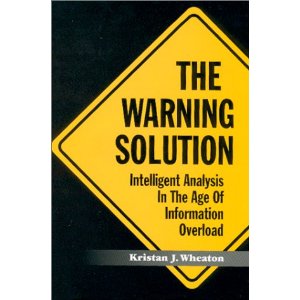
There is a fourth reason. (Major) Kristan Wheaton, USA (Ret) The Warning Solution : Intelligent Analysis in the Age of Information Overload (AFCEA, 2001) is the single best author on why warning fails in military command circles, and I consider his wisdom a fundamental foundation for any intelligence manager with a desire to actually be effective at warning.
04 Warning of future challenges based on human understanding is always over-shadowed by much more threatening and expensive immediate geo-political or budgetary crises. As Kristan put it in one of his briefings, every time an intelligence professional tries to present “an ounce of prevention” pre-emptive low-cost intervention, the “decision-maker” is over-whelmed with the crisis of the day, or with an inter-service budget battle, or some other drain on their all-too limited attention span. In financial terms, again recollecting Kristan's direct experience with NATO years before Bosnia-Kosovo, “anytime you have a warning that requires a billion dollars to fix in the future, the decision-maker is dealing with a fifty billion dollar crisis right now” to which I add: that could have been prevented had his predecessor listened to the pertinent warning ten years earlier.

I would also add as a complement to the above, the deep insight from Ben Gilad, Early Warning: Using Competitive Intelligence to Anticipate Market Shifts, Control Risk, and Create Powerful Strategies (AMACOM, 2003), to wit, he makes the point that surprise does not occur for lack of indicators that can be detected, but for lack of a culture and mind-set open to seeing and understanding those indicators. Our job is to have the mind-set to see, and the ability to communicate what we see to our leaders and deciders–our job is to continuously revitalize the mind-set of the leaders we support. This is a HUMAN function, not a technical function. In the same book, Ben points out “Top managers’ information is invariably either biased, subjective, filtered or late. . . . Using intelligence correctly requires a fundamental change in the way top executives make decisions.” THAT is the fundamental challenge of serious intelligence managers: change the way top executives make decisions. There is a very strong ethical component that Maj Douglas A. Prior, USA and Phi Beta Iota address elsewhere. Done right, intelligence is both decision-support and a cloak of (ethical) righteousness.
Part III. Today, right now, what can we do to dramatically improve the ability of the military — not just a single military but a multinational coalition military also working with civil sector partners — to get a grip on the human factor, and equally important, how should overt human sources be handled, and who should be responsible for collecting, processing, analyzing, and disseminating human understanding relevant to military strategy & priorities, military policy-making, military acquisition, and military operations?
If one understands the corruption of process that has taken hold of all government functions including military policy-making, acquisition, and to a lesser but still significant extent, military operations planning and execution, then the “craft of intelligence” has no alternative — and a very bright future — if it embraces the challenge of being a truly all-source all-topic decision-support profession. A few thoughts along these lines:
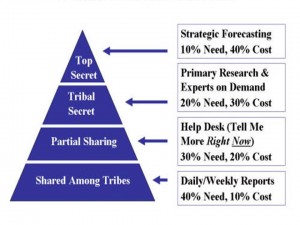
01 Intelligence is decision-support–intelligence is an output not repeat not a melange of inputs or worse, very expensive classified information. For decades now I have been concerned with the FACT that the tens of billions of dollars we spend on intelligence collection has not been accompanied by a commensurate investment in processing, analysis, or the communication of decision-support to all possible consumers of intelligence. Jim Schlesinger came to the same conclusion in his 1970's study of the secret world, and he briefed his findings again to my conference in 1996. Nothing has changed. It is time for each service, department, and agency manager of intelligence to accept responsibility for providing decision-support to every decision-maker (strategy, policy, acquisition, operations), without regard to whether the sources and methods are secret or not. I like to say that information costs money, intelligence makes money. Decision-support should impact on hundreds of billions of dollars more than it costs. Jan Herring, one of the OSINT pioneers in the 1970's, created this graphic, and it is still relevant. It takes deep intelligence and deep integrity to persist with paying attention to the top two tiers of 360 degree intelligence, and to invest the human time and the financial resources called for in this schema.
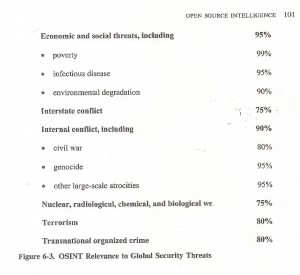
02 80-95% of what we need to know to make effective decisions is not secret, not digital, and often not in English. It is irresponsible to ignore — or to allow the intelligence function to ignore — a majority of the information sources relevant to the ten high-level threats to humanity, as shown in the graphic to the side (created for my 2008 chapter Open Source Intelligence). These are THREATS, not angels on the head of a pin or some other esoteric topic. THREATS. Not only are these threats, but the human factor is paramount within these threats, all of which are deeply human in their manifestation, be it poverty, epidemics, genocide, or trade in women and children, to take only four of the ten threats.
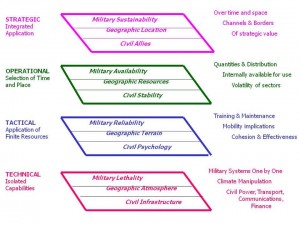
When you add LOGISTICS — always the red-headed step-child lcoked in the closet when it comes to standing in line for decision-support — the reasons for rebooting strategic, operational, tactical, and technical intelligence are compelling. If you factor in the reality that the elements of government outside of the military do not have professional intelligence services as we do in the military — I consider what passes for intelligence in law enforcement to be very shallow — and the reality that both in domestic emergencies and in foreign contingencies, the military is the only effective player when it comes to mobility, shelter, communications, and sustenance on the fly, the case for achieving excellence in OSINT within the military, both for military strategic, policy, acquisition, and operations needs AND for Whole of Government centered on military hub support, becomes for me at least, quite clear. Here above is the model that guided the first Marine Corps Intelligence Center study, for which I was Study Director, Planning and Programming Factors for Expeditionary Operations in the Third World (MCCDC, 1990). Note that the civil slice is the human slice, and Civil Psychology is central to the operational level of war and peace.
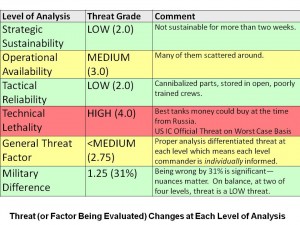
Now add to this a further nuance, one neither understood nor practiced among the military service intelligence centers, nor at DIA or CIA. The threat changes based on the level of analysis, and a significant part of the threat assessment at the tactical level is human with the added importance of off-setting what is often, at the technical level, a theoretically very high threat.. Please don't misunderstand me — the national and defense agencies know how to evaluate tactical human readiness in theory — what they do not know how to do is distinguish among the four levels of threats within any given campaign area — and what we do not have is pervasive persistent human access to tactical units world-wide including paramilitary and police units as well as gangs.
On top of this focus on the training and mind-set of the troops, remember how important military biographics have been in history, and join me in lamenting the sorry state of military biographics today. When I was in El Salvador in a time of war–and in my later clandestine postings–I noticed that the defense attache biographies of Salvadoran military commanders were written on the basis of what could be picked up at cocktail parties. They did not know, as I did, that one particular Colonel was notorious for using up his radio batteries to power a personal television when he was in the field. Or recollect the importance of Patton's reading Rommel's book on tank warfare tactics, the importance of the writings of Soviet Admiral of the Fleet Sergei Gorshkov, who in turn valued the writings of our own Captain Alfred Mahan.
I am quite certain we do not have an inventory of translated and thoughtfully analyzed writings of all of the Chinese ground, sea, and air commanders, nor do we have an inventory of every statement any Chinese officials has ever made with respect to the Spratley Islands, to take just one example. We certainly do not have this for Viet-Nam or the Philippines either. Clauswitz was quite clear on the importance of the human over the physical, and not only with respect to the enemy's ability to bear with deprivation and fear, but also with respect to our own troops being so deeply trained as to respond without question under the most terrible of circumstances–the USS Cole and the damage control team's success comes to mind.
Part IV. What role should external human factors play in our own military decision-making, and who is responsible for understanding and interpreting for the commander, the human environment?
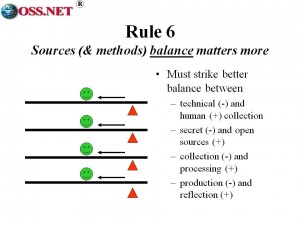
The human is both the Wild Card and the weak link in any clash of competing forces. As hackers have demonstrated over and over, there is no cyber-security system invented that cannot be penetrated with social engineering or innovative thinking. It took NSA a very long time to figure out the Chinese were riding the electric circuits into restricted areas — I figured that out the first time I bought one of those two-piece Best Buy gadgets that turns your home electrical system into a USB cord. The human — and especially the human collective in those instances where clarity, diversity, and integrity come together — is the greatest force on the planet.
The US secret intelligence system has failed because it is over-invested in technical collection, under-invested in human collection, human analytics, and human interaction, and no one has held it accountable for producing meaningful timely decision support to strategy (we do not have one), policy (we have an ideologically-rooted mish-mash), to acquisition (we can no longer build a ship or sustainable aircraft), or to operations (4% “at best”). I would dare to venture that the 21st Century is going to be about the restoration of HUMINT over TECHINT, but HUMINT must be defined much more broadly, and the practice of HUMINT must pervade every element of the intelligence cycle. HUMINT and OSINT — OSINT is part of HUMINT not repeat not a technical discipline. Here are a few concluding thoughts:
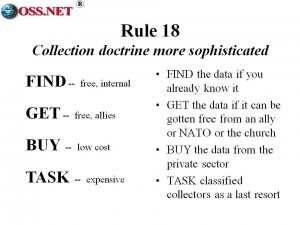
01 Requirements Definition. Although no one does serious requirements definition for the military today (going mission area by mission area, determining the 3-5 degrees of difficulty for each arrow in that mission area's quiver, and then determining the human factors that determine whether the level of efficacy at which the physical system will work), it is the human requirements specialist interacting with the human commander and mission area specialist, that will devise that collection and evaluation plan. We do not have any. I would love to train a dozen of them. This is the where DIA has neglected the fundamentals, because it is a bureaucracy far removed from policy, acquisition, and operations.

02 Collection Management. A major part of the the responsibility of a properly performing collection manager is to NOT assign any requirement to HUMINT that can be met by OSINT (Find, Get, Buy) or TECHINT. At the same time, in order to justify organic clandestine HUMINT capabilities, the collection manager must keep track of the systemic persistent failure of CIA to deliver on any HUMINT requirements — but the requirements have to be levied with precision and have due dates. I seriously doubt that precision requirements have been levied on CIA these past few decades with respect to the Chinese “string of pearls” strategy and I really doubt that we have a map of the key human assets supporting the Chinese at each of those “pearl” locations. CIA has not been held accountable because the Pentagon has not been honest with Congress — it decides what to buy (fewer bigger more expensive less useful as a rule) and then invents the requirements. Now that money is short, not only do we have to buy more with less, we actually have to buy the right stuff, not some contractor's wish list. It may take a while, but the intelligence profession just became relevant for the first time in modern history — relevant to strategy, relevant to policy, relevant to acquistion, and relevant to operations (Whole of Government operations that the military needs to learn to demand, not just full spectrum military operations).
03 Human and Open Source Collection. I am 60 years old and I have spent 40 of those years in the intelligence profession, acquiring two graduate degrees and a Naval War College education along the way, while also serving six clandestine tours (three in the field, three in HQS assignments) and being the senior civilian responsible for creating the Marine Corps Intelligence Center from scratch. The persistent shallowness of our human collectors and our open source collectors (such as they are), as well as our analytsts including our mid-career analysts, continues to astonish me. I know what the gold standard is in HUMINT and OSINT, I set the gold standard for holistic analytics, and we are not even close. If — and only if — we adopt a full-spectrum HUMINT approach to HUMINT, integrating OSINT and getting serious about M4IS2, immersing our analysts in the 80% of they are not able to access now, will we be competent to support strategy, policy, acquisition, and operations now that the money has run out and we have to actually create a military that is affordable, sustainable, and effective in every clime and place.
03 Analytics. Among the many mistakes of the US secret world has been the terrible assumption that child analysts will do well as long as they have access to secret sources. This is preposterous, especially if one is fully witting of the mediocrity of US national technical collection capabilities and the non-existence of US national processing capabilities — NSA is incompetent at all but a few of the 183 languages that matter, and generally days if not months late in processing critical traffic from out of the way places — Benghazi, for example. Put bluntly, I see two paths for radical advances at a very affordable cost in US intelligence: first, get serious about HUMINT and OSINT together; and second, hire a whole new crop of mid-career analysts that have proven themselves outside the secret world, and give them a global network of multinational counterparts to work with total protection from an antiquated security process that stopped thinking in the early 1970's.
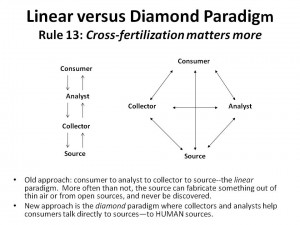
04 Decision-Makers. I knew from 1985 onwards that CIA's clandestine collection was a joke, one reason I quit the clandestine service and went to work for the DA in the Office of Information Technology, and then the DI in Collection Requirements and Evaluations Staff/Advanced Programs & Evaluations Group (CRES/APEG). In 1994, after several years of reflection about OSINT and what really mattered in decision-support, I realized that all of our intelligence production was make-work, generally on an 18 month editing cycle with idiots at multiple points in the review process. This is when I realized that the acme of skill for the 21st Century intelligence analyst is to “know who knows” (I learned this bit from Stefan Dedijer in 1992) and (my elaboration) to be able to put a decision-maker with a question in touch with a human that can create the answer on the spot, tailored to the need. I call this the diamond paradigm, and provide her the graphic I briefed in the Canada along with a link to that work. At the same time, when HUMINT comes up with a critical answer, it may be tempting to just put the answer into the system and trust the analysts to meld it in, but today I would go beyond that passive step, and make a personal call on the commander or program manager who originated the requirement, and deliver the answer, human to human.
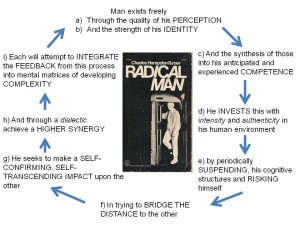
I want to end with my original model for predicting revolution across the varied domains of any nation-state: political-legal, socio-economic, ideo-cultural, techno-demographic, and natural-geographic. My work in this area, summarized for the Marine Corps University, is deeply indebted to Charles Hampden-Turner, Radical Man: The Process of Psycho-Social Development (Doubleday, 1972). Hampden-Turner identified key HUMAN FACTORS that determined whether an individual was able to exist to their full potential. His work stands to this day as a superb foundation for analyzing any society, including that of the USA where many more factors of instability are present than most people realize.
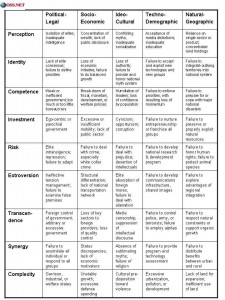
Using his model of personality, combined with my comprehensive review of the literature on revolution, I created the analytic model shown here to the side, while also operationalizing (identifying specific data that could be collected) each factor. It should be obvious that no “high threat” technology is going to be fully effective if individuals are not trained at the tactical level to use; if operational commanders are forbidden to use it (the Apache helicopter sidelined in Kosovo-Bosnia), or if political leaders do not see the value of a military solution. Similarly, very “low tech” technology — C4 around the submarine antennas or around the cranes at Long Beach — can have a devastating impact.
TECHNICAL INTELLIGENCE DISAPPOINTS
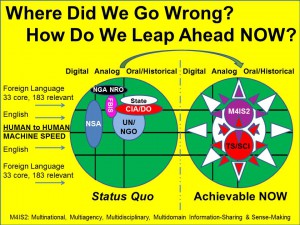
The “American Way of War” is thoughtless and undisciplined. Professor Anthony Echevarria II of the US Army War College does a very fine job in multiple publications, but especially in his book Clausewitz and Contemporary War (Oxford University Press, 2007), documenting our “strategic decrepitude” with respect to military policy and military acquisition, and military operations. The lies we tell ourselves are frightening — the lies we tell Congress to justify systems we do not need, cannot afford, that will not work as advertised, is troubling. Here to the side is a current integrated version of my long-standing slides on where we went wrong in over-investing in narrow but obscenely expensive technical collection, while under-investing in processing, human, and open sources as well as analytics.

Now here is the relative satisfaction of the various disciplines — originally a CIA slide — showing the complete absence of an all-source processing capability, twenty years after this slide was first created — 80 databases or more, zero integration. When all is said and done, the military professional is left with intelligence and integrity. Intelligence without integrity is not intelligence, and integrity without intelligence is stupid. The human factor is the central factor in developing strategy, developing policies, pursuing acquisition of force structure, and in operations. If we fail to understand the human factor, both of our potential enemies and allies (some allies vastly more dangerous to America than pupported enemies), and of our commanders and their senior civilian advisers. we are destined to fail.
TECHINT (Signals, Imagery, Measurements & Signatures) disappoints because it does not actually do “plans and intentions,” nor is any technical discipline holistic in and of itself, as much as it may have pretentions in that direction (as the joke goes, the NSA definition of all-source is SIGINT, COMINT, and FISINT). TECHINT) is by its very nature cold, mechanical, distant, and removed from human reality.
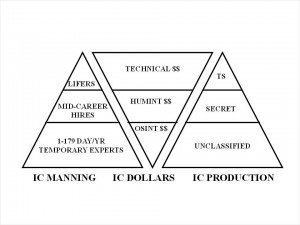
HUMINT–and particularly full-spectrum HUMINT with conjoined blended OSINT that can glide easily within the fifteen-slices and mix and match among M4IS2 collaborators–is the center of gravity for sound strategy, sound policy, affordable and sustainable acquisition, and victorious operations.
Here is a final slide, devised decades ago, on where the West — and the USA particularly — need to go with respect to manning, dollars, and production.
The human factor is ROOT for the intelligence professional. St.
See Also:
21st Century Intelligence Core References 2.1
2012 USA Human Intelligence (HUMINT) Scorecard 1.1
2009 DoD OSINT Leadership and Staff Briefings
2008 DIA NDIC Multinational Intelligence Fellows
2002: New Rules for the New Craft of Intelligence (Full Text Online for Google Translate)
2000-2002 NATO OSINT Handbooks
Books on Intelligence & Information Operations by Robert David STEELE Vivas et al
- Handbooks (64)
- Analysis (13)
- C4/JOE/Software (4)
- HUMINT (11)
- Law Enforcement (12)
- Military (19)
- OSINT Generic (17)
- Stabilization (19)
- Threats/Topical (13)
- UN/NGO (19)



